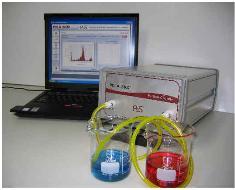Why Do We Need to Measure Particle Concentration?
Determining the particle characteristics of various products and biological materials is increasingly reliant on the measurement of particle concentration, alongside particle size. It is a crucial metric in a range of industries and academic studies, where products are manufactured to microscopic parameters or where quality assurance – or research – must be maintained and carried out at a molecular level. The process of measuring particle concentration is important to researchers and engineers in biopharmaceuticals, protein aggregation studies, nanomaterial characterization, and more. This article will explore in more detail the various industries and schools of research which measure particle concentration:

Nanomaterials are commonly referred to as a material with particles of nanoscale dimensions of between 1 – 1000 nanometers (nm). In 2011, the European Commission clarified that definition to include specific requirements of particle concentration for a material to be categorically defined as nanomaterial. It describes a nanomaterial as: “
A natural, incidental or manufactured material containing particles, in an unbound state or as an aggregate or as an agglomerate and where, for 50 % or more of the particles in the number size distribution, one or more external dimensions is in the size range 1 nm – 100 nm.” Precise measurement of particle concentration is required to ensure that any new materials are correctly identified and regulated accordingly. This is a crucial metric for materials scientists in a range of fields to consider.
Pharmaceutical
Studying the particle concentration of cell biology allows scientists and researchers to accurately assess drug delivery and optimize biological responses to drug administering by measuring the particle concentration of the delivery vector. It can also help industry leaders to understand drug stability under a range of environmental factors such as temperature and humidity, influencing best practice on how to manufacture and administer a wide range of pharmaceuticals. Laboratory tests that measure the particle concentration and size of antibodies, white and red blood cells, and platelets in a blood sample are commonly performed in the development and manufacture of vaccines, particularly in the assessment of vaccine dosages and their subsequent performances. It is a crucial factor in the evaluation of immunization success and the analysis of perceived biological resistances.
Soil Analysis
Despite innovations in emergent materials for use in a range of commercial and emergency service sectors, natural sediments and soils are still a primary material for the implementation of flood protection, foundation-laying for construction, and of course, agriculture. Measuring the particle concentration of soil helps to characterize the applications of various soil samples, for example in the distinction of soil types ideal for drainage and aeration from those that are highly compatible with various crops.
Water Treatment
Specialists in the water treatment sector are required to perform consistent and precise assessments of the cleanliness of drinking water for human consumption. Dedicated metric hardware that analyses the particle concentration of drinking water can quickly determine that samples are free of contaminants, including solids and bacteria, ensuring that water treatment is carried out to stringent industry standards.
Particle Analysis Solutions from Meritics
Meritics is the UK’s leading supplier of particle characterization instruments and laboratory services, with a range of accurate and reliable equipment that is applicable to many disparate fields. These include:
- The POLA 2000, which is a light obscuration measurement system which analyzes oils and hydraulic fluids, with further water-based applications;
- Flowcam dynamic imaging instruments, which can distinguish particles such as protein aggregates from other contaminants from 3μm to several hundred microns, with the provision for accurate particle shape analysis;
- The Multisizer 4e, which is the most broadly applied particle counting and sizing instrument, providing high resolution and excellent statistical accuracy, with a sizing range of 0.2µm – 1600µm.
- Spectradyne nCS1 resistive pulse based instrument for counting and sizing biological materials such as EV’s and exosomes down to 50nm ( 0.05µm)
If you would like any more information on the applications of the
particle concentration analyzers we supply, please do not hesitate to
get in touch.

